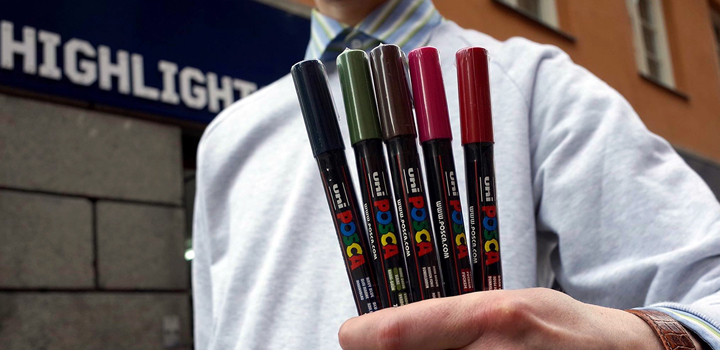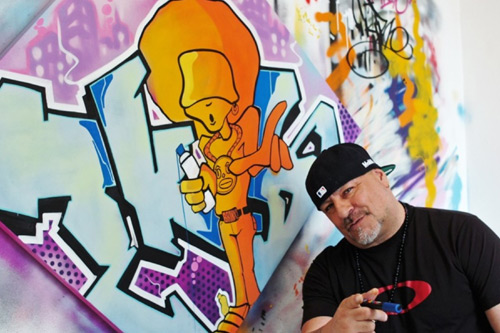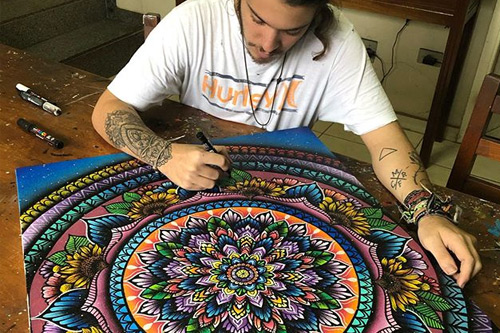POSCA from japanene Uni has been around since the late 80s in graffiti circles. The markers from POSCA work on most substrates and do not bleed on paper, but the main reason they became so popular in graffiti is that the colors in POSCA markers, like spray paint, cover each other. Uni Posca Markers - a true classic!

As early as 1886, Uni Mitsubishi Pencil started their operation in Tokyo. Through traditional Japanese craftsmanship, Posca produced pens of the highest quality. Fast forward a century, after countless innovations on the market, the company releases its POSCA pen in 1983. A revolutionary marker from Posca with water-based ink, 4 different nib sizes and 22 colors to choose from. It would becom an immediate hit with both artists and home and hobby businesses. The color formula in a posca pen, which is still unsurpassed today, has been the same since the beginning, consisting of pigments of the highest quality that are resistant to different temperature/weather conditions as well as to the test of time.


POSCA found a loyal customer group early on in the first generation of graffiti painters who appreciated the properties of the posca pen. With the thick covering paint, you could work on paper in a similar way to spray paint on a train or a wall. Today, probably every graffiti artist has a bunch of POSCA pens at home on their desk. In the years to come, the brand grew even more among artists, do-it-yourselfers, street artists, illustrators, designers, scrapbookers and others in the hobby business, POSCA expanded its range of colors and odd sizes to complete the scale and target even more customers.
POSCA today has no less than 8 different sizes with 5 different shapes of tips, made of acrylic or plastic. They are made of durable material to always ensure a compliant, even line. The vault is made so that you pump out paint when needed and which at the same time seals the bottom and preserves the paint. Given the pen's thick matte color, it doesn't bleed through the paper and all the pens cover each other. You can e.g. make white details over a black surface. POSCA has a ball that is shaken so that the colors are mixed to the max. Today POSCA has over 50 colors with e.g. fluorescent and metallic colors, and can be used on everything from paper, stone, wood, glass, metal, cardboard and much more!
POSCA and wood, both treated and untreated, go well together. If the material is treated or lacquered, it is a good idea to sand down the surface a little so that you get a good attachment surface. Paint with POSCA in as many layers as the wood needs and finish with a water-based varnish for best results and to make the whole thing more durable.
To use POSCA on textiles or leather, it is recommended to wash the textile in a machine before or with leather that it is washed with a damp cloth and allowed to dry. POSCA is highly absorbent on the natural material and several layers may be required depending on the texture and material. Drying time can vary as well. Fix the color by ironing on the back of the fabric, with a piece of baking paper in between or if that doesn't work, using a hair dryer approx. 30cm from the surface with circular movements.
POSCA on glass is popular and it is recommended to first clean the glass of all dirt and grease. Let dry and then draw with POSCA. Many layers are often needed on glass because it is difficult for the paint to adhere, especially when covering larger surfaces. Only lines can work on a first try. Spray two layers of water-based varnish with a distance of 30 cm. NOTE. The color must not be consumed!
The same applies to ceramics and porcelain. However, if you have made a design with POSCA on untreated ceramics or ceramics, you can fix it by curing it in the oven. For ceramics, place your object in the oven and slowly heat up to 220 degrees, then turn off and allow the oven to cool. For porcelain, a maximum temperature of 160 degrees for 45 minutes.
For POSCA on cardboard, paper, plastic, metal, stone and canvas, no special preparation is needed except that the surface must be dry, clean and free of grease. Materials such as metal and plastic may need a few extra layers, both POSCA and lacquer to hold better.
© 2001–2024 Highlights/KR Distribution AB.
Highlights Est. 2001
info@hlstore.com